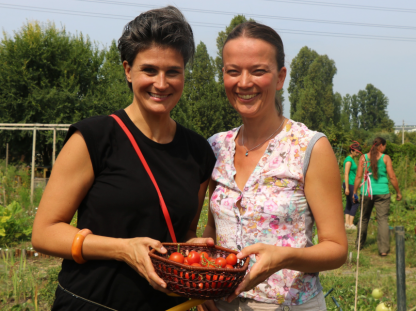Landrace tomato varieties among the Highlights of Hungary
Of the nearly 370,000 flowering plant species worldwide, only 200 are used for food production, and of these 200 plant species, just nine account for more than half of global crop production.
We are seeking to change this tendency of genetic loss by researching and disseminating landrace varieties of one of the most popular ingredients in Hungarian cuisine – the tomato. The unbroken popularity of these excellent landrace varieties is shown by the fact that they were also nominated as Highlights of Hungary candidates.%20(2).jpg)
The aim of our landrace variety tomato experiment was to rediscover the most suitable landraces for organic cultivation in Hungarian gardens, so that we can once again enjoy their special richness of colour and shape, as well as their succulent taste. In the first years of research, 35 tomato landraces requested from the National Centre for Biodiversity and Gene Conservation (NBGK) were examined in 28 cooperating organic farms across the country. From 2015, 10 selected landrace tomato varieties were examined in more detail across three growing seasons, in cooperation with the Szent István University. The varieties judged to be the best on the basis of cultivation results, tastings and nutritional content tests were presented in 2017, in the context of a seedling adoption campaign, and in view of the great interest and success, they have been sold in a nationwide supermarket chain since 2019. Since last year, handover points in Budapest have also been helping to return landrace varieties to Hungarian gardens.
In addition to the Máriapócs cocktail tomato, the Cegléd yellow and the Tolna Straggler were added in 2020, and this spring the customers can get to know a pale purple, egg-shaped tomato with a very special taste, which originates in the town of Fadd, Hungary.%20(1).jpg)
Why are landscape varieties so important?
Based on 2014 data, of the 369,000 flowering plant species worldwide, only 200 are used for food production. Even more thought-provoking is a 2017 statistic, showing that only 9 of those 200 plant species account for more than 66% of global crop production. The problem with this is that these crops, in parallel with the loss of their genetic diversity, are becoming vulnerable to the increasingly extreme and unpredictable effects of climate change. Landrace varieties, which are populations created by both natural and human selection, have a diversity which allows them to adapt to ever-changing environments, weather and market needs. They are a genetic resource for a more resilient, locally adapted, sustainable agricultural model that guarantees farmers' independence and, last but not least, they enrich gastronomy and introduce diversity into our diets.
Highlights of Hungary is a non-profit initiative which has been awarding and widely disseminating the best of Hungarian creative achievements since 2014. This year's nominees were assembled by the Highlights of Hungary ambassadors, under the slogan of DO, CREATE, ENRICH.
Our programme was recommended by Richárd Farkas, the chef of Pajta Bistro in the Hungarian Őrség region, who got to know the ÖMKi landrace tomatoes when he participated at an event with them last summer. Chef Farkas, who was given the Dining Guide Restaurant of the Year Sustainability Award, accepted the title of ÖMKi landscape tomato ambassador by adopting forty seedlings. To celebrate the 2020 harvest, he and Dóra Havas, the gastroblogger behind the Purple Fig (Lila Füge), presented the unique gastronomic possibilities of different organic landrace varieties. This joint cook-out, held in the ÖMKi garden, drew attention, among other things, to the fact that these unique-tasting, local landrace tomatoes, which are well adapted to environmental influences, are not only suitable for traditional cuisine, but can also hold their own against imported ingredients at the very highest level of a new local gastronomy committed to sustainability.
“The tomato is one of the most popular ingredients in Hungarian cuisine, but most Hungarians think first of Italian and Spanish varieties. These diverse and high-quality landrace varieties were known to very few people before the work of the Research Institute of Organic Agriculture. Through their work, we can proudly use, buy or grow landrace seedlings in our kitchen gardens, or even on our balconies.” Ambassador Richárd Farkas expresses his high opinion of landrace tomato varieties.
Those who grow landrace, organic tomato seedlings contribute not only to preserving their own health, but also to protecting our agricultural heritage and environment. At the same time, they support domestic sustainable farming, including small producers.
Vote for us here! Let's promote landrace varieties and organic farming together!
.jpg)







